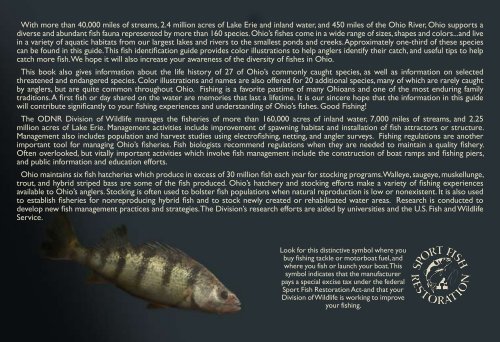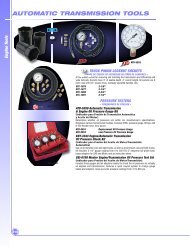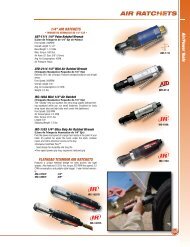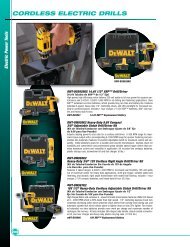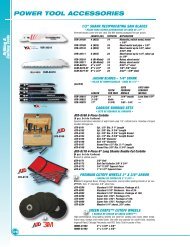SPORT FISH OF OHIO identification
SPORT FISH OF OHIO identification
SPORT FISH OF OHIO identification
Create successful ePaper yourself
Turn your PDF publications into a flip-book with our unique Google optimized e-Paper software.
With more than 40,000 miles of streams, 2.4 million acres of Lake Erie and inland water, and 450 miles of the Ohio River, Ohio supports a<br />
diverse and abundant fish fauna represented by more than 160 species. Ohio’s fishes come in a wide range of sizes, shapes and colors...and live<br />
in a variety of aquatic habitats from our largest lakes and rivers to the smallest ponds and creeks. Approximately one-third of these species<br />
can be found in this guide. This fish <strong>identification</strong> guide provides color illustrations to help anglers identify their catch, and useful tips to help<br />
catch more fish. We hope it will also increase your awareness of the diversity of fishes in Ohio.<br />
This book also gives information about the life history of 27 of Ohio’s commonly caught species, as well as information on selected<br />
threatened and endangered species. Color illustrations and names are also offered for 20 additional species, many of which are rarely caught<br />
by anglers, but are quite common throughout Ohio. Fishing is a favorite pastime of many Ohioans and one of the most enduring family<br />
traditions. A first fish or day shared on the water are memories that last a lifetime. It is our sincere hope that the information in this guide<br />
will contribute significantly to your fishing experiences and understanding of Ohio’s fishes. Good Fishing!<br />
The ODNR Division of Wildlife manages the fisheries of more than 160,000 acres of inland water, 7,000 miles of streams, and 2.25<br />
million acres of Lake Erie. Management activities include improvement of spawning habitat and installation of fish attractors or structure.<br />
Management also includes population and harvest studies using electrofishing, netting, and angler surveys. Fishing regulations are another<br />
important tool for managing Ohio’s fisheries. Fish biologists recommend regulations when they are needed to maintain a quality fishery.<br />
Often overlooked, but vitally important activities which involve fish management include the construction of boat ramps and fishing piers,<br />
and public information and education efforts.<br />
<br />
Ohio maintains six fish hatcheries which produce in excess of 30 million fish each year for stocking programs. Walleye, saugeye, muskellunge,<br />
trout, and hybrid striped bass are some of the fish produced. Ohio’s hatchery and stocking efforts make a variety of fishing experiences<br />
available to Ohio’s anglers. Stocking is often used to bolster fish populations when natural reproduction is low or nonexistent. It is also used<br />
to establish fisheries for nonreproducing hybrid fish and to stock newly created or rehabilitated water areas. Research is conducted to<br />
develop new fish management practices and strategies. The Division’s research efforts are aided by universities and the U.S. Fish and Wildlife<br />
Service.<br />
Look for this distinctive symbol where you<br />
buy fishing tackle or motorboat fuel, and<br />
where you fish or launch your boat. This<br />
symbol indicates that the manufacturer<br />
pays a special excise tax under the federal<br />
Sport Fish Restoration Act-and that your<br />
Division of Wildlife is working to improve<br />
your fishing.


